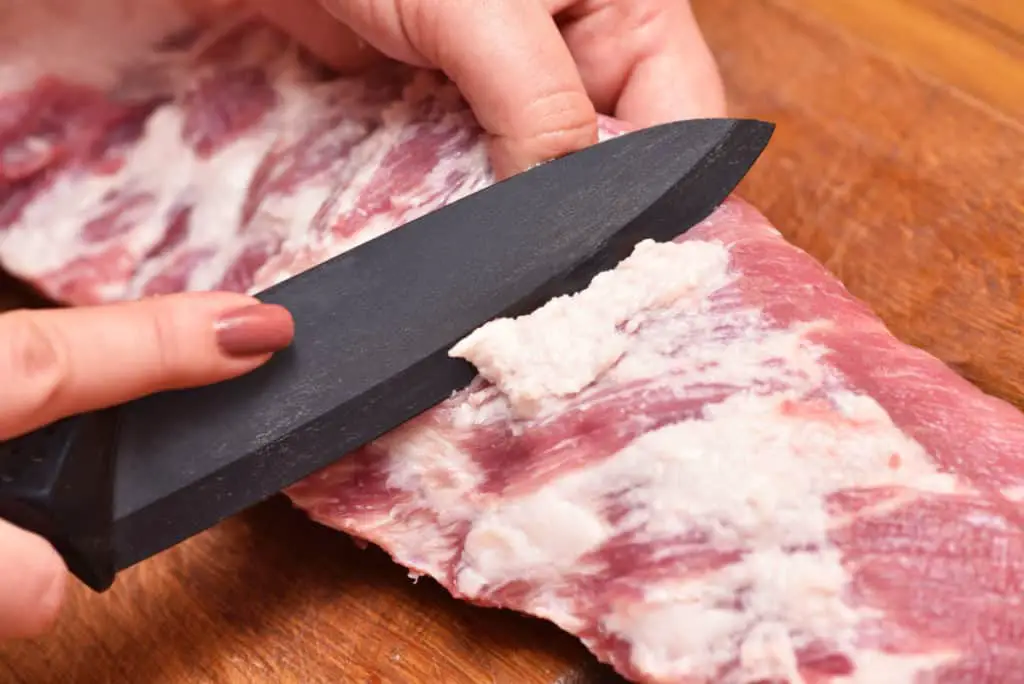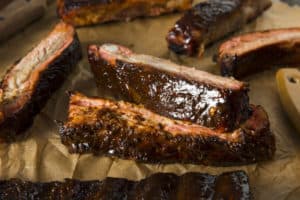Smoke Meat Fat Side Up or Fat Side Down? The Truth Revealed
Disclosure: This post may contain affiliate links. If you use these links to buy something we may earn a commission at not additional cost to you. Learn more.

You invited your neighbor over for a barbeque and he won’t stop talking about how you should be smoking your brisket fat side up. But your dad taught you fat side down. It’s a part of the meat, so does it really matter which side the fat is facing?
It does not matter which side the fat is facing, whether that’s up or down. Both have different pros and cons, however, there is no “best” way to orient the fat when smoking it. The fat side should be used mainly to protect the meat from the heat source. If you are heating from the bottom, go with fat side down; if from the top, choose fat side up.
There are some meats that various smoking chefs tend to prefer a way to cook with the fat side facing a certain way. This article will discuss these preferences, as well as the various pros and cons of cooking different types of meat with the fat side facing up or down.
Fat Side Up
If the fat is facing upwards it can act as a baste for the meat while it smokes. The fat will melt around the meat to keep it moist. However, it won’t always penetrate the meat unless you tenderize it. If it is tenderized it can get into the meat and keep it moist. It won’t soak into the meat because the fat is oil-based and the meat is water-based. Water and oil do not mix in real life so they won’t magically mix in a smoker.
As the fat melts a bit while it is smoked, it will fall off the meat. In some cases it will bring your seasoning with it, making your food less flavorful. Make sure to have a grease, oil, fat, etc. catcher beneath your meat. This will help prevent flare-ups from grease dripping on your coals or the hot surface of the smoker.
There are some meats that this method may work better for like pork or lamb, but you can really smoke any meat fat side up.
Fat Side Down
A lot of people prefer to place their meat with the fat side down because the fat is something that protects the meat. It will keep that side of the meat from getting too crispy, rubbery, or burnt. This method is better if your heat source is right below your meat because the fat is thick enough to prevent too much heat from getting to one side.
However, this method increases the possibility of flair-ups because the fat is right there to drip down onto the coals of a hot smoker. With this method, it is extra important to have a grease catcher to prevent the flare-ups from happening too much.
This method works best when you’re cooking with beef. If you are smoking turkey or chicken, smoke with the skin down when applicable. But, like the previous method, you can smoke any meat with the fat side down.
Flipping the Meat
If you are really concerned about how the fat cooks and you want to moisten the meat without having it drip too much seasoning off, you can always flip the meat. The only main downside is that your meat may have to smoke a bit longer. Opening and closing the lid every hour or so can release a lot of the heat and smoke that’s needed for cooking.
This method works with all meats.
Hanging Smoker
If you would like to skip the part where your father and neighbor argue about which side to face the fat while smoking, just get a Drum-shaped or Vertical Smoker and some great meat hooks or hangers. With this method, the meat is just hanging above the coals and the fat isn’t necessarily facing up or down, just to the side. For different meats, you can get different hooks. For example, you can get ones to hang bacon over and others that hold onto the whole turkey.
Pork-Up
For pork meat, it can taste great whichever side you smoke the fat on, but having it face up is more common in the recipes you find online. A lot of these recipes say that the meat will be juicier if you cook fat side up and that it won’t drip as much.
Smoking pork face up also helps with basting it as well. The video below talks a bit about how it doesn’t really matter what side the fat is, but it does show a delicious-looking pork butt that was cooked fat side up. The best way to do this is to make the cuts in the meat on top so the fat can melt into the meat.
When cooking with pork you should focus a lot more on making it tender and juicy. It should be falling apart when you’re done cooking it; this is also a good way to tell the meat is cooked to perfection. The fat doesn’t really affect it. If you watch this other video about cooking pulled pork, he doesn’t mention whether to cook it fat side up or down.
The pork will usually have a thick layer of fat that you should cut off. Other little bits of fat on the meat can be okay, but just make sure to cut off the bigger pieces of fat. If you are going to eat the pork as leftovers a couple of days later, the fat could become rancid. The more light and air that hits your fat the faster it goes rancid. It is best to make it in portions that will be used sooner rather than later. If you are making food to store or use later, cut off as much fat as you can to keep the meat well preserved.
Beef-Down
For beef, it is recommended to cook fat side down because the beef should be protected more from the heat, but that is only if your heat source is below the beef. If it is off to the side (like an offset smoker), it doesn’t really matter which side you cook it on. Various recipes also recommend fat side down to prevent too much fat dripping down and bringing the seasoning with it. Just make sure to have a drip pan beneath your meat!
If you are making jerky, it is best to trim off all the fat. Doing this will help lengthen the shelf life of the jerky because there isn’t any fat on the meat that could go rancid over time. When smoking jerky, you can use your grill or normal smoker, but you could also invest in a verticle smoker or drum smoker because it is built better for making jerky.

One of the best ways to make ribs is to follow the 3 2 1 method. What this means is that after you season the ribs, you’ll smoke them for about three hours. This just gets the general seasoning into the meat. Then you’ll wrap the ribs in some foil and cook them for about 2 more hours. This helps with basting them and usually, you add a liquid of your choosing inside for basting. Finally, you cook the ribs for one final hour with a BBQ sauce and set in the sauce. For recommendations on how to use this method, use this recipe.
Lamb-Up
Lamb is very similar to pork in the way it should be cooked. Lamb, like pork, is recommended to cook fat side up in various recipes like this one. Lamb should be kept moist while cooking/smoking and having its fat side up will keep the lamb moist while cooking. It is also said that sometimes keeping the fat will help keep the flavor in the meat. The flavoring that you put on the fat will melt into the meat while it cooks with the flavoring, giving it a deeper flavor than just on the surface.
Chicken-Flip
If you are cooking a chicken breast or thigh usually only one side has the skin, while a wing is usually surrounded by skin. The skin is the fattier part of the chicken. Chickens still have fat, but it is more common to chop off the fat before cooking or smoking it because it is usually on the side in chunks and doesn’t add to the meat. In some rarer cases, a cook will cut off the skin because of the recipe they are using or the way the chicken is going to be presented after.
So how do you cook the skin of the chicken when smoking it?

A lot of chefs will say to cook the thighs, breasts, and wings by flipping it at least once or twice. Since it is such a thin layer, the skin isn’t as likely to melt off the meat, take any seasoning with it as it melts, protect the meat from the heat, or add moisture to the meat. However, if you cook it the right way it really adds to the chicken, making it flavorful and crispy.
Before you add any flavoring to your meat, use a tenderizer on it. This helps loosen the fat a bit and had some small little holes in the skin to let flavoring sink into the meat while it cooks. Doing this also helps prevent the skin from becoming rubbery and tough while it cooks. Then when it comes to cooking it, you should make sure to flip the meat at least once halfway through cooking.
Doing this will help make the skin very crispy, but also prevent it from becoming so burnt or cooked that it becomes rubbery. For wings, you will probably flip the meat a bit more while smoking to make sure it gets cooked all the way around and all the skin gets crispy.
Here is a video that shows how to cook various types of chicken meat to perfection and to get that crispy skin.
Turkey-Flip
Turkey is very similar to chicken in the way you would smoke it. Make sure to cut off excess meat as well as the skin (if you don’t want skin later on). There are some people who will cut the skin because it makes the meat a little less fatty and a little more healthy. If you do decide to keep the skin on, make sure to tenderize it. You don’t need to tenderize the meat when you cook wings (this also applies to chicken). Then when it comes to cooking, don’t forget to flip it at least once or twice to keep the skin from becoming burnt or rubbery.
If you are going to cook a whole turkey or chicken, I would recommend getting a drum or vertical smoker because it will make it easier to cook all sides of the meat without burning one side or the other. You can buy a turkey or chicken hook off of Amazon usually, which lets it hang over the coals in your vertical smoker. You won’t need to tenderize the meat before cooking a whole turkey. Also, when the meat is hanging, it doesn’t need to be flipped as often.
Here is a great smoked turkey recipe to follow.
Salmon-Down
Salmon should be smoked with the fat side or skin side down. The first step is to pre-heat your smoker to 200 degrees. Next place the salmon on heavy-duty tin foil before placing it on the smoker. Salmon usually will take 2-3 hours to fully cook on the smoker, but it does not need to be flipped.
Users on smokingmeatsforum.com say that something good to try when smoking salmon is to cut off the skin and remove all of the dark meat. This makes the meat taste better.
When finished cooking the salmon, the internal temperature on the thick side should be at least 160 degrees. Smoked salmon is said to be a very flavorful meal and easy to cook so beware of becoming addicted to it.
Here is a smoked salmon recipe video:
Conclusion
Now next time you are told by your friend how you should be smoking your meat, instead of going against what you’ve been taught by your dad, you can acknowledge that friend for also being right. This is because there is no definitive “right-side-up” when it comes to smoking meat. It just depends on what kind of meat you have and which way your preferences lie.







